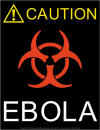
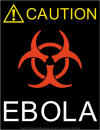
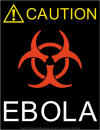
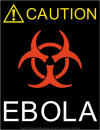
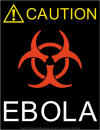
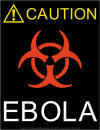
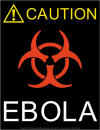







image from co.bazmag.hu/tmp/
EXPERIMENTAL FINDINGS SINCE 2002
Development
of Potential Treatments (Drug Profiles)
Use
of "harmless-Ebola-like particles" as a vaccine
The discovery of the harmless-Ebola-like particles (eVLPs) led researchers to investigate whether or not they could confer immunological protection from Ebola virus infection. These eVLPs were found to be immunogenic both in vitro and in vivo. According to one study, these VLPs "matured and activated mouse bone marrow-derived dendritic cells, assessed by increases in cell-surface markers CD40, CD80, CD86, and MHC class I and II and secretion of IL-6, IL-10, macrophage inflammatory protein (MIP)-1alpha, and tumor necrosis factor alpha by the dendritic cells" (abstract). Mice were also vaccinated with these eVLPs, and they "developed high titers of Ebola virus specific antibodies, including neutralizing antibodies." Furthermore, all the mice in the study were protected from Ebola virus inoculation.
http://jama.ama-assn.org/cgi/content/full/287/11/1381
"Surprise finding spurs ebola researchers' hopes," JAMA, 2002; 287:
1381-1382
http://www.ncbi.nlm.nih.gov/entrez/query.fcgi?cmd=Retrieve&db=PubMed&list_uids=14673108&dopt=Abstract "Ebola virus-like particles protect from lethal Ebola virus infection," Proc Natl Acad Sci USA. 2003. Dec 23; 100 (26): 158889-94. Epub 2003 Dec 12.
http://jama.ama-assn.org/cgi/content/full/291/5/549
"Ebola vaccines tested in humans, monkeys,"
JAMA 2004; 291: 549-550
A new vaccine was tested in macaque monkeys and was
found to confer "protection from Ebola infection only four weeks after a
single jab." Researchers used an adenoviral vector to encode Ebola
glycoprotein, the envelope protein that is responsible for receptor binding and
membrane fusion. While Ebola vaccines in the past took approximately six months
and multiple boosters to confer immunity, this vaccine, if proven effective in
humans, may be able to induce immunity quickly enough to stop Ebola outbreaks.
http://www.nature.com/cgi-taf/DynaPage.taf?file=/nature/journal/v424/n6949/full/424602a_fs.html "Fast vaccine offers hope in battle with ebola," Nature 424, 602 (07 August 2003)
Use
of potent
inhibitor of tissue factor-initiated blood coagulation
A new therapeutic regimen for Ebola hemorrhagic fever was recently tested in rhesus macaques. A recombinant nematode anticoagulant protein c2 (rNAPc2), an inhibitor of tissue factor-initiated blood coagulation, was administered in rhesus macques to determine whether the uncontrolled coagulation cascade could be stopped and thereby prevent hemorrhagic fever and septic shock from occurring. The macques in the experimental groups were given the anticoagulant protein either ten minutes or twenty-four hours after a high-dose lethal injection of Ebola virus, and both treatment regimens were found to prolong survival time. While all the macques in the control group did not survive, approximately a third of the macques in the experimental groups survived. The implications of this study are that post-exposure protection with rNAPc2 may "provide a new foundation for therapeutic regimens that target the disease process rather than viral replication."
http://www.ncbi.nlm.nih.gov/entrez/query.fcgi?cmd=Retrieve&db=PubMed&list_uids=14683653&dopt=Abstract "Treatment of ebola virus infection with a recombinant inhibitor of factor VIIa/tissue factor: a study in rhesus monkeys
A
potent inhibitor of study was recently carried out on cyanovirin-N (CV-N), a
human immunodeficiency virus (HIV)-inactivating protein that is "known to
potently inhibit the infectivity of a broad spectrum of HIV strains at the level
of viral entry" (abstract). The Ebola envelope has similar oligosaccharide
constituents as the N-linked high-mannose oligossacharides of HIV viruses, which
suggests that Ebola is susceptible to CV-N inhibition.
The results of the study indicated that CV-N exhibited antiviral activity
in both in vitro and in vivo against the Zaire strain of the Ebola virus.
CV-N not only inhibited the development of viral cytopathic effects (CPEs),
but it delayed the death of Ebola infected mice. The authors of this study
believe that these findings "broaden the range of viruses known to be
inhibited by CV-N, and further implicate carbohydrate moieties on viral surface
proteins as common viral molecular targets for this novel protein" (abstract).
http://www.ncbi.nlm.nih.gov/entrez/query.fcgi?cmd=Retrieve&db=PubMed&list_uids=12719006&dopt=Abstract "Cyanovirin-N binds to the viral surface glycoprotein, GP1,2 and inhibits infectivity of Ebola virus," Antiviral Res. 2003 Mar;58 (1): 47-56.
Researchers have discovered that oligomerization of VP30 could be
inhibited by a synthetic peptide, EP30pep-wt, to prevent transcription of Ebola
virus-specific mRNA. The peptide
was found to inhibit viral replication, which suggests that the "inhibition of
VP30 oligomerization represents a target for EBOV antiviral drugs" (abstract).
http://www.ncbi.nlm.nih.gov/entrez/query.fcgi?cmd=Retrieve&db=PubMed&list_uids=12912982&dopt=Abstract "Oligomerization of Ebola virus VP30 is essential for viral transcription and can be inhibited by a synthetic peptide," J Biol Chem. 2003 Oct 24; 278 (43): 41830-6. Epub 2003 Aug 11.
A diagnostic test was recently developed for the Ebola virus, which could potentially be used in remote regions of Africa where diagnostic facilities are limited. An antigen capture enzyme-linked immunosorbent assay was created to detect the structural proteinVP40 in human serum. This diagnostic test could become a very useful tool for obtaining an accurate diagnosis in the field, one that could be handled and distributed easily.
"Development, characterization and use of monoclonal VP40-antibodies for the detection of Ebola virus," J Virol Methods. 2003 Jul; 111 (1): 21-8
Antiviral activity of nanoemulsions, which are a new form of disinfectant composed of detergents and vegetable oil suspended in water, was investigated against EBO. Inactivation of the virus in tissue preparations was also complete, but required 1:10 dilutions with media or higher. Nanoemulsion is an effective disinfectant for EBO and "because of the excellent biocompatibility of nanoemulsions, studies are planned to determine whether the nanoemulsion-killed virus is suitable for developing a vaccine against EBO."
"Inactivation of Ebola virus with a surfactant nanoemulsion," Acta Trop. 2003 Aug; 87 (3): 315-20
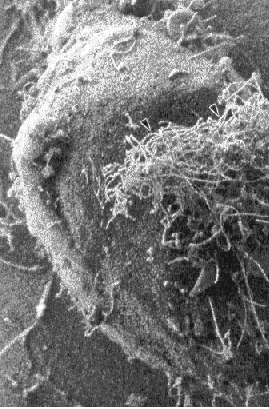

Ebola virus on a cell, www.er1.com/-x/-c/-lib/ -dir/-docs/photos Ebola virions, http://www.the-scientist.com/yr1998/jan/notebook_980119.html
Studies have found that a harmless-Ebola-like particle can be created by coexpression of the virus glycoprotein (GP) and matrix protein (VP40) using a viral vector. When expressed in mammalian cells, virus-like particles "that resemble the distinctively filamentous infectious virions" are spontaneously produced.
http://www.ncbi.nlm.nih.gov/entrez/query.fcgi?cmd=Retrieve&db=PubMed&list_uids=14673108&dopt=Abstract
"Ebola virus-like particles protect from lethal Ebola virus infection,"
Proc Natl Acad Sci USA. 2003. Dec 23; 100 (26): 158889-94. Epub 2003 Dec
12
A recent study has discovered that Ebola viruses
target and disable dendritic cells, which serve as the link between innate and
adaptive immune responses. Human dendritic cells in culture that were infected
with Ebola viruses were not found to induce cytokine secretion. The study
discovered that "infected DC cultures supported exponential viral
growth without releasing interferon (IFN)
![]()
![]() and
were impaired in IFN-
and
were impaired in IFN-
![]() production if treated with double-stranded RNA. Moreover, EBOV
and MARV impaired the ability of DCs to support T cell
proliferation, and infected, immature DCs underwent an
anomalous maturation." The importance of this study is that it
provides a reasonable explanation for why Ebola virus infections are so deadly;
they delay effective host responses.
production if treated with double-stranded RNA. Moreover, EBOV
and MARV impaired the ability of DCs to support T cell
proliferation, and infected, immature DCs underwent an
anomalous maturation." The importance of this study is that it
provides a reasonable explanation for why Ebola virus infections are so deadly;
they delay effective host responses.
http://www.journals.uchicago.edu/JID/journal/issues/v188n11/30753/30753.html
"Ebola and Marburg viruses replicate in monocyte-derived
dendritic cells without inducing the production of cytokines and full
maturation," J Infect Dis. 2003
Dec 1; 188 (11): 1630-8. Epub 2003 Nov 14
Coagulation abnormalities may
occur much earlier than previously thought
A recent study focused on TF expression/release from
Ebola infected monocytes/macrophages. As a key factor that creates
coagulation irregularities, TF overexpression was investigated in 25 macaques,
which was found to exist at increased levels in peripheral blood-cell RNA by the
third day of infection. Primary
human monocytes/macrophages (PHMs) were also analyzed after Ebola infection and
were discovered to have elevated levels of TF during the first two days of Ebola
viral infection. Apparently,
coagulation abnormalities begin at the onset of viral infection, but cause
profound manifestations later in the time course of the disease. The authors
conclude that "chemotherapeutic strategies aimed at controlling
overexpression of TF may ameliorate the effects of EBOV
hemorrhagic fever."
http://www.journals.uchicago.edu/JID/journal/issues/v188n11/30697/30697.html
"Mechanisms Underlying Coagulation Abnormalities in
Ebola Hemorrhagic Fever: Overexpression of tissue factor in primate monocytes/macrophages
is a key event," The Journal of
Infectious Disease 2003; 188: 1618-1629